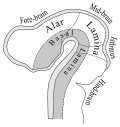Alar plate
Alar Plate[edit]
The alar plate is a critical structure in the developing central nervous system of vertebrates. It is part of the neural tube, which eventually forms the brain and spinal cord. The alar plate is primarily involved in the development of sensory neurons and is located dorsally in the neural tube.
Development[edit]
During embryogenesis, the neural tube forms from the neural ectoderm through a process called neurulation. The neural tube is initially a simple, hollow structure, but it soon differentiates into distinct regions. The alar plate is one of these regions, situated dorsally, while the basal plate is located ventrally.
The alar plate gives rise to the dorsal horn of the spinal cord, which is responsible for processing sensory information. In the brain, the alar plate contributes to the formation of structures such as the cerebellum and the thalamus.
Function[edit]
The primary function of the alar plate is to develop into structures that process sensory information. In the spinal cord, the neurons derived from the alar plate receive input from sensory neurons and are involved in the transmission of sensory signals to the brain.
In the brain, the alar plate contributes to the development of regions that are involved in sensory perception and integration. For example, the thalamus, which is derived from the alar plate, acts as a relay station for sensory information traveling to the cerebral cortex.
Clinical Significance[edit]
Abnormal development of the alar plate can lead to various neurological disorders. Since the alar plate is involved in the formation of sensory pathways, defects in its development can result in sensory processing issues. Understanding the development and function of the alar plate is crucial for diagnosing and treating such conditions.
Related Pages[edit]
Gallery[edit]
-
Diagram of the neural tube showing the alar plate.
-
Cross-section of the spinal cord illustrating the alar plate.
-
Alar plate
-
Gray642
Ad. Transform your life with W8MD's Budget GLP-1 injections from $75


W8MD offers a medical weight loss program to lose weight in Philadelphia. Our physician-supervised medical weight loss provides:
- Weight loss injections in NYC (generic and brand names):
- Zepbound / Mounjaro, Wegovy / Ozempic, Saxenda
- Most insurances accepted or discounted self-pay rates. We will obtain insurance prior authorizations if needed.
- Generic GLP1 weight loss injections from $75 for the starting dose.
- Also offer prescription weight loss medications including Phentermine, Qsymia, Diethylpropion, Contrave etc.
NYC weight loss doctor appointmentsNYC weight loss doctor appointments
Start your NYC weight loss journey today at our NYC medical weight loss and Philadelphia medical weight loss clinics.
- Call 718-946-5500 to lose weight in NYC or for medical weight loss in Philadelphia 215-676-2334.
- Tags:NYC medical weight loss, Philadelphia lose weight Zepbound NYC, Budget GLP1 weight loss injections, Wegovy Philadelphia, Wegovy NYC, Philadelphia medical weight loss, Brookly weight loss and Wegovy NYC
|
WikiMD's Wellness Encyclopedia |
| Let Food Be Thy Medicine Medicine Thy Food - Hippocrates |
Medical Disclaimer: WikiMD is not a substitute for professional medical advice. The information on WikiMD is provided as an information resource only, may be incorrect, outdated or misleading, and is not to be used or relied on for any diagnostic or treatment purposes. Please consult your health care provider before making any healthcare decisions or for guidance about a specific medical condition. WikiMD expressly disclaims responsibility, and shall have no liability, for any damages, loss, injury, or liability whatsoever suffered as a result of your reliance on the information contained in this site. By visiting this site you agree to the foregoing terms and conditions, which may from time to time be changed or supplemented by WikiMD. If you do not agree to the foregoing terms and conditions, you should not enter or use this site. See full disclaimer.
Credits:Most images are courtesy of Wikimedia commons, and templates, categories Wikipedia, licensed under CC BY SA or similar.
Translate this page: - East Asian
中文,
日本,
한국어,
South Asian
हिन्दी,
தமிழ்,
తెలుగు,
Urdu,
ಕನ್ನಡ,
Southeast Asian
Indonesian,
Vietnamese,
Thai,
မြန်မာဘာသာ,
বাংলা
European
español,
Deutsch,
français,
Greek,
português do Brasil,
polski,
română,
русский,
Nederlands,
norsk,
svenska,
suomi,
Italian
Middle Eastern & African
عربى,
Turkish,
Persian,
Hebrew,
Afrikaans,
isiZulu,
Kiswahili,
Other
Bulgarian,
Hungarian,
Czech,
Swedish,
മലയാളം,
मराठी,
ਪੰਜਾਬੀ,
ગુજરાતી,
Portuguese,
Ukrainian

